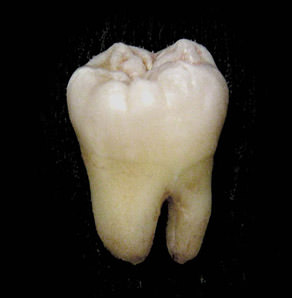
Dentists, just like lawyers, accountants and doctors are guilty of talking gibberish from time to time. We don’t mean to, but we forget that the terms we use everyday are often a foreign language to our patients. With this in mind I thought it might be worth showing everyone just exactly what makes up a tooth and how it all fits together. The basic parts of a tooth are listed below with some photos of how they look and what happens when they are damaged.
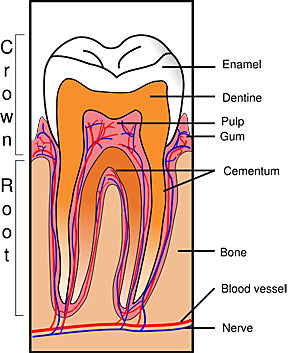
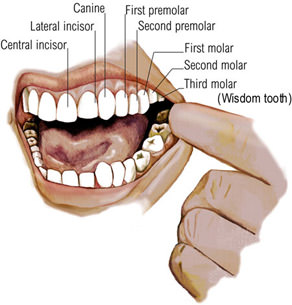
Enamel
Enamel is the hardest and most highly mineralized substance of the body, and with dentine, cementum and dental pulp is one of the four major tissues that make up the tooth. It is the normally visible dental tissue of a tooth and must be supported by underlying dentine. Ninety-six percent of enamel consists of mineral, with water and organic material composing the rest. The normal colour of enamel varies from light yellow to greyish white. At the edges of teeth where there is no dentine underlying the enamel, the colour sometimes has a slightly blue tone. Since enamel is semi-translucent, the colour of dentine and any restorative dental material underneath the enamel strongly affects the appearance of a tooth. Enamel varies in thickness over the surface of the tooth and is much thinner at the neck, which is why this area often appears more yellow.
Dentine
Dentine is the substance between enamel or cementum and the pulp chamber. It acts as a protective layer to the pulp and supports the crown of the tooth. It is secreted by cells known as odontoblasts of the dental pulp, which is a process that can continue if the pulp is under attack from decay. The porous, yellow-hued material is made up of 70% inorganic materials, 20% organic materials, and 10% water by weight. Because it is softer than enamel, it decays more rapidly and is subject to severe cavities if not properly treated,
Cementum
Cementum is a specialized bony substance covering the root of a tooth. Its coloration is yellowish and it is softer than either dentin or enamel. The principle role of cementum is to serve as a medium by which the fibres of the periodontal ligaments can attach to the tooth for stability. If the root becomes exposed this layer can be lost often leading to sensitivity from the affected area.
Pulp
The dental pulp is the central part of the tooth filled with soft connective tissue. This tissue is filled with blood vessels and nerves that enter the tooth from a hole at the apex of the root. Along the border between the dentin and the pulp are odontoblasts, which initiate the formation of dentin. The pulp is commonly called “the nerve” of the tooth and it is responsible for the growth and formation of the tooth. When the tooth decays it is the pulp that gives the sensation we know as toothache.
The gums and supporting tissues
The periodontium is the supporting structure of a tooth, helping to attach the teeth to surrounding tissues and to allow sensations of touch and pressure. It consists of the cementum, periodontal ligaments, alveolar bone, and gingiva. Cementum is the only one of these that is a part of a tooth. Periodontal ligaments connect the alveolar bone to the cementum. Alveolar bone surrounds the roots of teeth to provide support and creates what is commonly called an alveolus, or “socket”. Lying over the bone is the gingiva, which is the pink gum we see around the tooth.
The periodontal ligament is a specialized tissue that attaches the tooth to the bone. This tissue covers the root of the tooth within the bone. When pressure is exerted onto a tooth, such as during chewing or biting, the tooth moves slightly in its socket and stretches the periodontal ligaments. The nerve fibers can then send the information to the brain to let it know how hard the jaws are biting. It is these nerve fibres that stop us smashing our teeth together when we are biting really hard on something, like a Polo mint that then breaks in two.
The alveolar bone is the bone of the jaw that forms the support around teeth. This bone is lost if the tooth is removed, leading to a changing jaw shape in people who have lost lots of teeth. It is for this reason that dentures start to become loose after a few years of use.
The gingiva is the pink tissue that overlays the jaws. The gingival epithelium is not associated directly with tooth attachment but is instead the visible portion in the mouth. The top part of the gingiva touches but is not attached to the tooth. This leaves a small potential space between the gingiva and tooth that can collect bacteria, plaque, and calculus.
Plaque
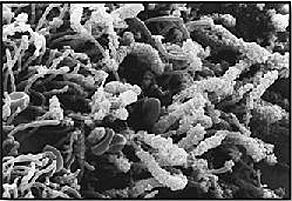
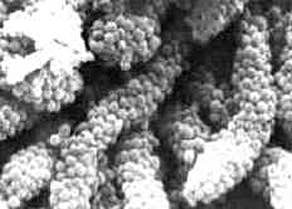
Plaque is a sticky smear of bacteria (as seen in the above photos) known as a biofilm. If not removed regularly, it can lead to dental cavities (caries) or gum problems (such as gingivitis and gum disease). Given time, plaque can mineralize along the gingiva, forming tartar or calculus. Certain bacteria in the mouth live off the remains of foods, especially sugars and starches producing acid in that can dissolve the enamel and dentine. This process, known as “demineralisation”, leads to tooth decay. Saliva gradually neutralises the acids, which allows the enamel to reform or ‘remineralise’. If there is sufficient time between the intakes of foods and these foods are not too sticky or sugary then the impact is limited and the teeth can repair themselves.
Tooth decay
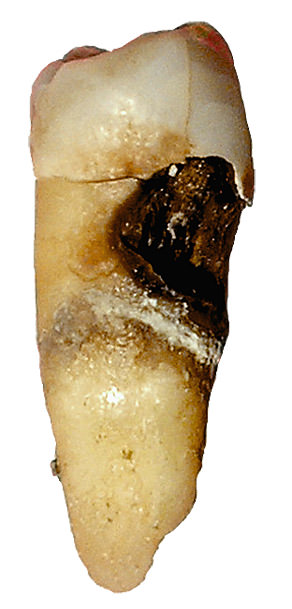
Dental caries, also described as “tooth decay” or “dental cavities”, is an infectious disease, which damages the structures of teeth. The disease can lead to pain, tooth loss, infection and, in severe cases, death (caused by severe dental infection – very rare now a days). There is a long history of dental caries, with evidence showing the disease was present in the Bronze, Iron and Middle age but also prior to the Neolithic period. The largest increases in the prevalence of caries have been associated with diet changes. Today, it remains one of the most common diseases throughout the world. Among children in the United States and Europe, 60-80% of cases of dental caries occur in 20% of the population meaning that decay is still hugely. affected by social and economic factors. Sadly in this country almost a third of children under the age of six have experienced tooth decay. Decay is best prevented by limiting the number of times sugar in any form hits the teeth and through regular daily use of a fluoride tooth paste.
I hope that this glossary of terms has been helpful to you and will make some of the explanations we give to our patients a little more understandable. If you would like to know more about any dental matter then please call the surgery on 01580 752202 and ask to speak to Victoria Eaton, our treatment co-ordinator, who will be only too happy to help.